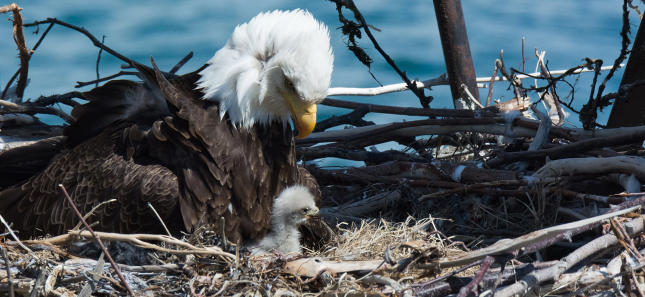
Did you know that in preparation to laying their eggs, which can happen from early March to early April here in Massachusetts, Bald Eagles often start building their nests as early as December? That’s because eagles build some of the largest nests in the bird world. Their nests can reach widths of over eight feet wide and up to 12 feet high! They can take up to three months to build and weigh hundreds of pounds! Eagle pairs may reuse their nest year after year, adding onto the existing structure and making it even bigger each nesting season. Eagles usually mate for life.
Eagles build their nests in trees of considerable size such as maples, oaks and pines by weaving together large sticks. Soft materials such as grasses, moss, pine needles and feathers are used to fill in between the sticks and soften the nest. Both the male and female eagles bring nesting material to the site, but it is the female that constructs the nest.
Once the nest is ready, the female will lay from one to three eggs (very rarely four) with the separation of a day or two between eggs. Both parents incubate the eggs, with the female spending more time on the nest and the male providing her with food. The incubation period lasts about 35 days, after which the first egg will begin to hatch. The eaglet will pip the egg to start the hatching process. A pip is a small hole the eaglet makes as it begins to break through the egg. If there is more than one egg in the clutch, the eaglet’s siblings will begin hatching at two to three day intervals.
When they first hatch, the eaglets are covered in a light gray down, measure four to five inches, weigh only a few ounces and need almost constant brooding from the mother - she sits on them as she did the eggs to keep them warm. During these early days, the father will provide the family with food. The eaglets grow quickly and can eat up to two pounds of fish a day! The father and eventually the mother feed fish, birds and mammals to the eaglets by breaking off small pieces of food and placing it directly into their beaks. By the time they are six weeks of age, the eaglets can tear off pieces of food and feed themselves from the prey brought to the nest by their parents.
By their ninth week the eaglets are fully grown and covered in dark brown feathers. Soon they begin making short flights to branches surrounding the nest and between their eleventh and twelfth week they make their first flights from the nest and the parents begin teaching them how to find and catch food on their own. The juvenile eagles will return to the nest and stay in the general vicinity with their parents until sometime in the fall when they are fully ready to hunt and care for themselves.
Once the juvenile eagles leave their parents, they can travel great distances looking for food. For the first four to five years of their lives they continue to travel, until the time they reach sexual maturity and begin establishing their own territories and looking for mates. This is also the point in their lives when their dark brown head and tail feathers molt completely into their adult white feathers.
Bald Eagles have undergone a remarkable resurgence here in Massachusetts. In the early 1900’s they had completely disappeared from the state due to habitat loss, hunting and pollutants such as DDT. In 1982, the Massachusetts Division of Fisheries and Wildlife began relocating 41 young eagles from Michigan and Canada into the area around the Quabbin Reservoir. That was the beginning of their remarkable recovery in the state. According to Mass Wildlife, we currently have over 90 pairs of Bald Eagles in Massachusetts, from the Berkshires to Cape Cod!

